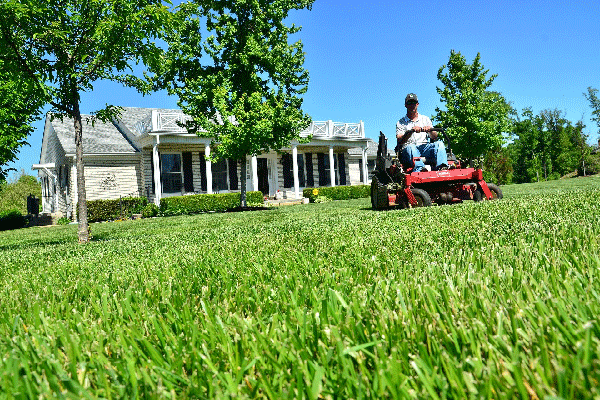Many Nebraska soils have high clay and silt content making them prone to compaction. Foot traffic from both human and pets, equipment and vehicles are all common causes of soil compaction. Look for the following as signs of potential soil compaction in your landscape.
- Areas where water puddles after rain
- Tracks or pathways where grass growth is sparse
- Hard packed soil at garden gates, edges of driveways or sidewalks
- Areas along the inside of a fence where dogs frequently run
Soil compaction reduces a lawn’s quality, growth and vigor by decreasing the amount of oxygen in the soil, slowing and reducing water infiltration, and decreasing grass root growth.
Core Aeration
In lawns, core aeration is the best way to reduce soil compaction. Plan to aerate compacted areas at least once per year, but if the compaction is severe aeration twice per year is even better.
Due to the high levels of clay and silt in Nebraska soils, hollow-tine core aeration is most effective. Other parts of the country with sandier soil may use solid-tine or spike aeration but those methods are not effective in clay/silt soil.
Note – this includes “aeration shoes”, which are basically spike aeration tools worn on your feet. Solid-tine and spike aeration push soil particles apart to allow the spike to enter the ground but increase compaction between the spike holes.
Hollow-tine core aeration pulls small plugs of soil out of the turf canopy, opening up the soil surface. As the soil cores break up, they filter back down into the grass canopy and speed up thatch break-down. This adds organic matter to the soil and improves soil particle aggregation. The soil openings are quickly filled by the growth of new grass roots. Repeated aeration improves soil structure, oxygen and water infiltration and improves grass root growth.
Cores should be approximately 3 inches deep to be most effective. If weather conditions are dry at the time you plan to aerate, water the lawn deeply 2 days beforehand to make it easier for the aerification machine to penetrate compacted soil and increase the depth of cores.
Wait until your lawn is actively growing to aerify. This allows the grass to quickly recover from any damage done during aerification and maximizes new root growth. Cool season grasses, including Kentucky bluegrass, fescues, and perennial ryegrass, can be aerated in spring from late March through the end of May and again in fall from late August through the end of October. Warm season grasses, such as zoysia and buffalograss, should also be aerated when they are growing actively, which is late May though late August.
Liquid Lawn Aeration
Recently a homeowner called Nebraska Extension asking if liquid aeration is an effective technique. They found products online claiming to provide an easy way to relieve soil compaction and wondered if they were effective. There are many such products, mostly from web-based companies, which claim to reduce soil compaction, but you might also find some lawn companies promoting similar products.
One web-based product claims it is “The ultimate soil conditioner for clay or compacted soil. Replaces the need for mechanical or core aeration. Reduces soil compaction and loosens clay.” Each company has its own private mixture, but they often contain soap-like materials, such as sodium lauryl sulfate, liquid humates (basically liquid organic matter like seaweed) and “biostimulants” like molasses. Directions are to spray the mixture onto grass and water it in.
There is no evidence any of these products have been scientifically evaluated for effectiveness. Bottom line - its wishful thinking to believe such a solution will have any effect on compacted soil.
Gypsum, which contains calcium sulfate (CaSO4), is another product often marketed as a cure-all for soil compaction, but it is also not effective. Gypsum can aid in the reduction of high soil salt levels. When applied to the soil, the sulfate molecule SO4-2 recombines with salt’s sodium molecule Na+, and together they can be leached out of the soil assuming the soil has good enough water percolation for leaching to occur.
There is no chemical substitute for core aeration in relieving soil compaction.
More information on managing your lawn:
- Cool Season Lawn Calendar - Eastern Nebraska, Nebraska Extension
- Management Calendar for Warm-Season Lawns, Nebraska Extension

